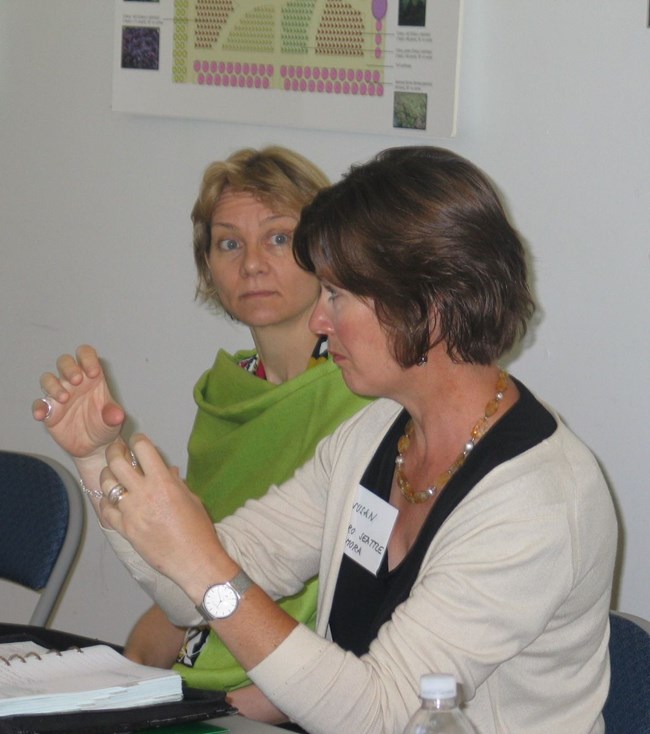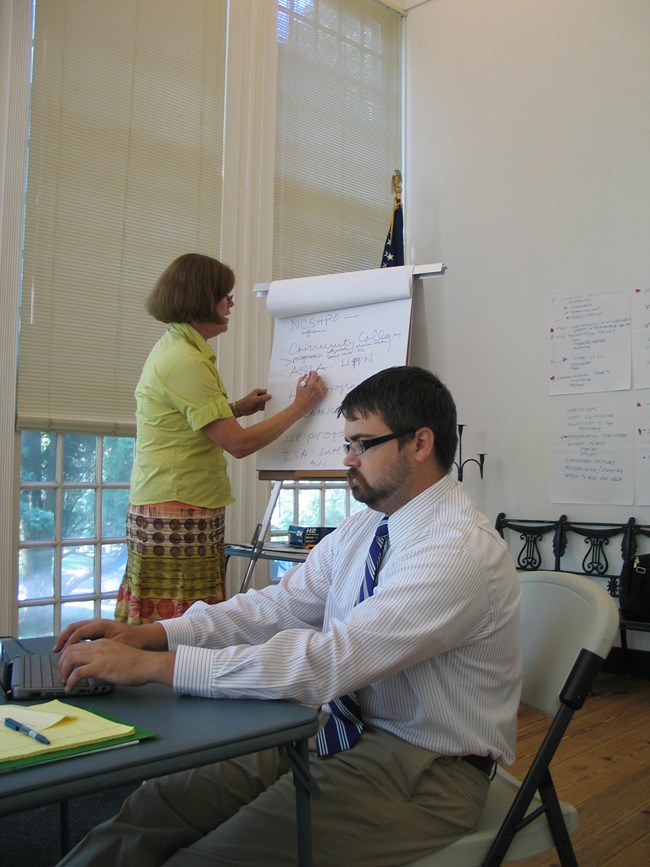Last updated: April 7, 2025
Article
Podcast 011: Curriculum Development for Preservation Landscape Maintenance

National Park Service
Bob Mackenzie
I’m Bob Mackenzie from the Adams National Historical Park and I’m here to help throw around ideas and brainstorm about developing curricula for landscape maintenance skills or just ideas that focus on historic preservation or preservation of historic landscape, historic fabric.
What I’d like to come out of this is some idea of a primer for anyone who is working on a historic landscape, primarily field people so that they get an idea of why we do things differently.
It’s a struggle sometimes to explain to a new employee or a seasonal employee who has been working in the private sector and has done it one way for so long, to try to explain to them why we do it the way that we do it and why it is important, to the whole concept of a historic fabric and why we need to protect this, why we can’t plant that, why we can’t mulch this, why we don’t use power equipment.

National Park Service
Susan Dolan
I’m Susan Dolan. I’m with Mount Rainer National Park. I’m a historical landscape architect. I also work in the Pacific West Regional Office in Seattle. I think that one of the most exciting things isthat we’re really defining a new position a new role, particularly for the National Park Service, speaking from that perspective, of landscape preservation maintenance specialist. We’re identifying what the central ingredients of a curriculum would be for training for that position and therefore essentially what are the qualifications or basic competencies someone would need in that role.
Christian Zimmerman
My name is Christian Zimmerman and I’m with Prospect Park and the Prospect Park Alliance. I think what’s been most interesting for me is the fact that there is this strong need to differentiate between regular park maintenance and historic preservation landscape maintenance in that there is a different component and with all the historic properties that are out there, including mine that there is an education component that needs to be brought to the maintenance workers.
One it would be very beneficial for them as well as to increase that skill set, and I think it would also help with a matter of pride that they are working in special places, and that it’s important that y recognize that, and the practices that they complete throughout the day are following certain guidelines, for the longevity of those historic properties. What I really appreciate about this group and what we’ve been doing is we are focusing on the field worker. It’s not just a management approach, it is a management approach for field workers because they’re the ones who really do fulfill those requirements in maintaining our public properties, our historic properties, so I really appreciate that and the fact that we’re trying to create this curriculum.
Iris Gestram
I’m Iris Gestram; I’m the executive director of the National Association for Olmsted Parks. What I found most helpful really is the, I think the diversity of perspectives around the table and I think the discussions in terms of one getting different perspectives but also sparking my own thinking.I think I bring a pretty diverse perspective in terms of public horticulture, historic preservation, and association management. Thinking about the resources that are out there already from the different organizations and how we might all incorporate and utilize them in a much more effective manner. I think in that way the workshop was really productive.

National Park Service
Tom McGrath
Hi, I’m Tom McGrath and I’m the superintendent of the Historic Preservation Training Center located in Frederick, Maryland, and we’re part of the National Park Service’s Learning and Development Division. Certainly the exciting point is the fact that we’ve been discussing training and development for the stewards; those people actually working on our historic landscapes, doing the preservation maintenance.
So it’s really where the rubber meets the road. I’m very excited any time we’re talking about addressing training needs for the rank and file National Park Service employees and also the other thing that I would say that’s exciting was the partners from the outside agencies and sites such as Monticello and Dumbarton Oaks that have really identical training needs.
I was involved in the practice category and I’m glad I was because I think I can contribute to that; I’m not a landscape architect, but an architect dealing with historic structures, however, the training program that we’ve developed to deliver training opportunities to our maintenance workers dealing with historic structures, called the PAST program, would be very similar in terms of its concept and delivery methods to training our landscape preservation workers, and so there’s a lot of cross-walking we could do of delivery methods, curriculum basing preservation philosophy, but the practice, the actual using tools, using equipment safely, recognizing materials, sourcing materials, all of those kinds of areas that we discussed have direct application both in preservation for building as well as for historic landscapes.
I certainly think we’ve identified a leadership group both within and outside the Park Service. Our friends at the Olmsted Center, Charlie Pepper in particular, has long experience in exactly this field, so we would love the opportunity to share our knowledge and expertise and help expand training opportunities for those maintenance workers in the National Park Service, but also the other thing I think is very exciting to wrap up, is that we start this new program with partners and look to develop it with partners, look for application both inside and outside the Park Service and I’ve never done something exactly like that so this would be exciting and I think would help with the success and make for a much better product at the end.
Beate Jensen
Hi, I’m Beate Jensen and I’m the Buildings and Grounds Preservation Supervisor at Gari Melcher’s Home and Studio in Fredericksburg, Virginia. Yesterday and this morning we will wrap up our conversation talking about maybe starting a program that will help the people that actually maintain the gardens understand the concepts of historic preservation or landscape preservation, and why working in a garden that has history to it would be different than working in let’s say a botanical garden. I find it very exciting there is so much information out there to share with the people on the ground, and I’m realizing that there is actually more than I thought.
Paul Bitzel
Hi, my name is Paul Bitzel. I am chief of resource management at Hampton National Historic Site and Fort McHenry National Monument and Historic Shrine in Baltimore, Maryland. I feel very strongly that the historic preservation ethic needs to be instilled in our younger staff, whether they’re maintenance or resource management staff.
Charlie Pepper
I think the joint efforts of Charlie Pepper and Tom McGrath’s organizations within the building and landscapes preservation efforts of training Park Service staff are really important, and I think the conversations that they’re having now to basically build the boat as it sails is a clever way to put it, but I think that time is of the essence, and I think that their programs are a good place to start. And I do believe that reaching out to the public sector, for instance with Dumbarton Oaks and Prospect Park in New York were a great start, and we need to continue to solicit the involvement of these and other organizations that are working toward the same goals.

National Park Service
Lucy Lawliss
My name is Lucy Lawliss. I am superintendent at George Washington Birthplace National Monument and the Thomas Stone National Historic Site, and I have been there just a year. It’s my first superintendency, but I come from a background with the National Park Service in the cultural landscape program.
I started in the southeast region as the first historical landscape architect and then after 10 years there, moved to Washington and was the lead for the cultural landscapes program, so the topic of historic landscape maintenance is a perfect fit for my career with the National Park Service.
The exciting thing is that we had an incredible array of expertise around the table from the people who are working in the field and know what those needs are to people who’ve just sort of been watching at a higher level of management but know that there are a number of unmet needs, and so one of the really important things is to go back and see what we already have that we can reshape and reformat for a different audience.
And so I believe that there is a number of things that have been done already in the recent past with the cultural landscapes program, both in Washington, regional, park level that could be brought together as sort of as a baseline group of information that could be made available and the technology isn’t my strength, but as we sit and listen to all the interesting possibilities with the web and social networking that we could get information out there to people who are looking for these kinds of answers and trainings.
And then I think most importantly is working to develop a full curriculum so someone who over a period of time and interest and support could specialize in a trade that is critical to the longevity of our historic sites. So we are working at it from both ends. It will be really exciting to get this all done.
Read other Preservation Technology Podcast articles or learn more about the National Center for Preservation Technology and Training.
